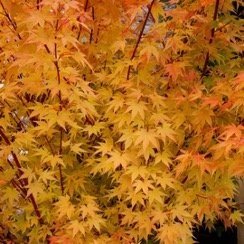
5 of the best… small trees for autumn colour
Lesley Ann SandbachIt’s the time of year when we find ourselves in danger of tripping over roots and uneven surfaces as we walk with our heads in the air taking in the sheer beauty of the trees around us. As trees begin to break down the green chlorophyll in their leaves and redistribute the nutrients to their trunks and roots, yellow or orange carotenes are revealed. Red is another chemical story: as some leaves die, they produce anthocyanins from built up sugars which produce the rich display of reds you see.
Although it does foreshadow the long, dark days of winter, I do love this exuberant fling as trees and shrubs put on their final firework burst before shedding their leaves and becoming dormant.
There are so many must-haves it’s almost impossible to choose five of them, but I have concentrated on smaller trees that can be grown in most gardens. So here are my five favourite small trees for autumn colour.
1. Acers
There are too many wonderful acers to name them all. Here are just a few:
· Acer x conspicuum ‘Pheonix’ – a good choice for the smaller garden as it reaches no more than 3m, produces rich, butter-yellow leaves and striated bark, tinged coral pink
· Acer palmatum ‘Sango-kaku’ turns a rich gold
· Acer palmatum ‘Westonbirt Red’ turns a deep, glowing red
· Acer palmatum ‘Orange Dream’ shows off its leaves in shades of orange and yellow; this is another bushy acer, which never gets too big and can be grown in a pot
· Acer palmatum ‘Garnet’ is a traditional favourite with its finely divided leaves which turn from garnet red to fiery orange in the autumn – another choice for a large pot
Sadly, acers do like a more acidic soil and one that is very rich in nutrients and organic matter. If, like mine, your soil tends to be alkaline, then try growing some of the smaller varieties in pots; put them in a position where their foliage will not be burnt by cold winds; keep them well fed and watered and they will reward you for years.
2. Liquidamber styraciflua
A spectacular taller tree whose leaves turn gradually through deep red to scarlet and orange. This is a tree for a larger garden, although there are some smaller species such as ‘Gum Ball’ in cultivation, which can be grown in a pot or as a standard pom-pom.
3. Parrotia persica ‘Vanessa’
In autumn, this deciduous tree is breathtaking as its large leaves turn brilliant yellow, then orange and finally fiery red before falling. It normally has multiple stems and it is best grown as a large shrub in the border or in an open woodland garden.
4. Sorbus or Rowan Tree
This is known to many of us as a scrubby wild tree on scree-covered mountain sides but there are a number of lovely, cultivated varieties:
· Sorbus ulluengenis ‘Olympic Flame’ is a compact tree which produces orange-red berries. The foliage turns lovely shades of yellow, red or purple in autumn. It can tolerate most soils, including clay.
· Sorbus aff. Cashmiriana is a charming small tree, which produces a profusion of clusters of pink or white flowers, followed by large white berries that enhance the russet and gold of the autumn leaves.
5. Prunus or cherry tree
Cherry is loved by many of us for its spectacular display of spring blossom before the leaves emerge but many of the cultivars produce lovely autumn foliage too.
· Prunus sargentii is one of the earliest trees to produce autumn colour, often displaying its fiery reds and oranges in mid-September; it is a small tree growing to no more than 10m
· Prunus ‘Royal Burgundy’: I am less fond of the pink-flowered cherries than the white, but this small tree earns its place for its rich wine-red leaves that turn blistering scarlet before they fall in the autumn
· Prunus 'Shogetsu' is considered by many to be one of the loveliest of all flowering cherries. The large, semi-double flowers are pink-tinged in bud, opening pure white; the mid-green summer foliage turns orange to red in the autumn.
Finally, not tree at all but I couldn’t resist including this Parthenocissus quinquefolia (Virginia Creeper), captured at Calcot Manor, looking like an abstract landscape:
I hope that’s given you some food for thought!









